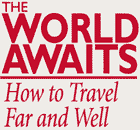|
|
| w o r l d a w a i t s . c o m |

|
Roadwise A column on the art of traveling well Roadwise Home The Unbeaten Path Travelers see the phrase all the time, but what exactly is the "beaten path"? While "path" seems like the simpler word of the two, I think "beaten" has the more obvious meaning—as in 'popular', 'well used', 'often taken', etc. The "beaten" path is the popular path. And since travelers tend to be a savvy bunch, we can assume that there are good reasons that certain paths are beaten, while others are ignored. On the other hand, the independent, adventurous traveler is often encouraged to "get off the beaten path" or to take "off the beaten path" tours. But what is meant by "path" in this catchy phrase—what is it that's being beaten? If we made a map that showed the routes taken by independent travelers across Europe, for example, we'd have an intricate web of lines. Most lines would follow major transit corridors. Lines would meet or cross at popular destinations and points of prime interest. Routes more heavily used than others would show up as darker lines. Should we simply pick the darkest lines and call them "beaten paths"? Perhaps "path" is a misleading term. Maybe we should ignore the connecting lines and look instead at the points of interest—the destinations. Would a list ranking the most popular sights, events, and travelers' hangouts reveal our "beaten path"? Or maybe "path" refers to the activities which are most popular among a segment of travelers. If you do what thousands of others have done—stay in hostels, see famous museums, drink in hip pubs, whatever—are you automatically following the "beaten path" The typical answer combines all of the above—if you go where many others have gone, see what many others have seen, and do what many others have done, you're on that "beaten path". But to me, the beaten path is really more an attitude than a transit route, destination set, or activity list. Specifically, it is someone else's attitude, and getting off the beaten path means shedding the attitudes, habits, and preconceptions that originated somewhere else and developing your own personal engagement with the world. Of course, when you design your journey, it's exceedingly difficult not to be heavily influenced by the attitudes and opinions of others. In fact, most of us often desire just that! Who wouldn't want the benefit of the experience and knowledge of those who've gone before? We buy guidebooks, consult agents, purchase passes and tours, take friendly advice, etc. We deliberately subscribe to the vision of others for the sake of being well prepared and using our time and money wisely. Yet, for many travelers, a central purpose of leaving home in the first place is to be free—to explore and discover, to respond to whim and inspiration, to be rid of the obligations and authorities that shape our home lives. Unfortunately, when we subscribe to the words and attitudes that characterize authors and guides—even entire publishing and tour companies—we become leashed to those people. Their choices and reviews shape our choices and reviews. The traveler who relies heavily on the wisdom of others is, in a sense, taking someone else's trip. That's what I call being "on the beaten path". Sometimes, the fresh experiences of the road will shake up travelers, showing them the narrowness and weaknesses of their guidebook wisdom. But many people don't even give themselve a chance to be awakened—they chain their minds even more by buying convenience and security. ...Hmmm, but aren't those good things? After all, it's nice to have those hostel and rail passes in hand. That RTW ticket means that you'll make it home somehow. Room reservations ease your mind while that pre-booked guided trek takes you safely over the edge. The structure of a detailed itinerary removes decision-making pressures. All true, but I say, cut those chains whenever you can! Look, I've gladly traveled with reservations, passes, pre-booked tours, guidebooks, etc. Many times, I've opted for exacting itineraries, standard must-see sights, critic-approved meals and beds, and more. But the greatest joys and most transformative experiences I've had on the road came during times when I felt truly free—times when I had no ticket, no reservation, no guide, no book, and basically no place in particular to go. There I was, no Lonely Planet Bob or Let's Go Betty nudging me along. Just me—and what "me" is is one of the things you discover when Bob and Betty are gone. "Beaten path" doesn't refer to where you travel, but to how you travel—or so it seems to this high-mileage mind. To find the unbeaten path, give yourself a chance to discover it as you go. Slim down your framework of certainties and add variety to those you keep. Use fewer reservations and pre-bookings. Add independent and other non-HIAYH hostels to the mix. Consider skipping the rail pass so you're more open to bus and hitchhike options. Use less opinionated guidebooks, or just a map, or nothing at all on occasion. But the two big things are to slow down and engage! Cut your planned mileage way down and walk as much of it as possible. Battle that language barrier and talk to folks. Avoid clustering too much with fellow travelers and get to know the locals a bit. And every once in awhile, give yourself a swift, random kick, and put a sharp turn in your routine—do something completely different. Traveling the unbeaten path feels quite different than subscribing to the canned "independent" budget adventure tourist shuffle. You begin to feel at home on the road. You discover not just the planet, but yourself. And once discovered, you can reinvent yourself—again and again and again, at every fork in the road. Happy Travels! Paul Otteson |